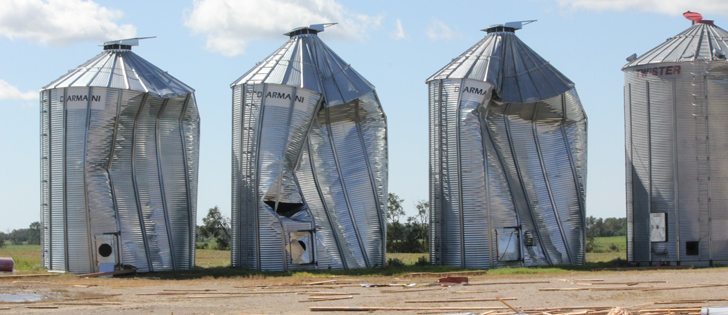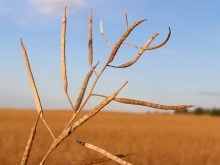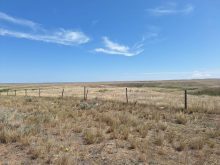It was raining and blowing so hard that Harold Wenning couldn’t see the barn from his house.
He knew the storm pounding east-central Saskatchewan June 26 was intense, but when it cleared, he saw just how much it had changed things.
The barn was gone; the ram inside was still there, however, sheltered behind a small panel.
Two storage sheds were destroyed along with part of the shop. Hopper bottom bins were tipped. The legs on the farm’s seed cleaning plant were bent and broken.
Read Also

Volatile temperatures expected for this winter
DTN is forecasting a lot of temperature variability in the Canadian Prairies this winter. Precipitation should be close to average.
“There’s six 14,000 bushel bins. They are crumpled up like pop cans,” Wenning said the next day. “There’s seven others. They are half a mile down the field.”
Ten acres of bush behind the farmhouse is now gone. Two-by-six boards protrude from tractor cab windows.
“We’ve still got the house, that’s pretty much it, and part of the shop,” said Wenning, who arrived with his parents from Holland six years ago to farm 5,000 acres.
The debris is scattered across fields and Wenning expects crops will be damaged. Surprisingly, there was no hail.
Across the province, Gerald Ewanchuk saw similar damage in the yard his family shares with his parents northeast of North Battleford.
The main shop was destroyed and bins blown away. The barn and equipment were damaged.
Ewanchuk said a neighbour’s weather station clocked the wind at 119 km/h before it blew away.
“The shop wall was thrown at Dad’s house,” he said. “Trees are uprooted. All the Scots pines are leaning to the northeast.”
Livestock scattered and had to be rounded up. Ewanchuk said the oats he grows for feed were flattened.
As bad as the damage is to deal with, he said the frightening part was learning his 16-year-old daughter had driven over live downed power lines on the highway on her way home.
She couldn’t tell where she was and her parents ended up helping to redirect other drivers around the lines before help arrived.
Countless other stories emerged after the massive June 25-26 storms. Provincial director of emergency response Duane McKay said no communities had declared disasters despite the heavy damage.
Widespread power outages affected tens of thousands of customers and as of June 29 there were still 2,300 without power.
SaskPower vice-president of transmission and distribution Mike Marsh said crews hoped to have many of those back online before the weekend but customers could expect outages as the system came back to normal.
Many rural customers were among the last to be reconnected, particularly in the Wakaw and Cudworth areas where a repaired line had failed, and in the Prince Albert, Melfort, Tisdale, Yorkton, Melville, Sturgis and Canora areas where extensive tree damage was the problem.
Trees in parts of the Nisbet Provincial Forest and Duck Mountain Provincial Park looked like toothpicks, said reports.
Efforts to repair transmission lines and reconnect customers were hampered by muddy conditions and excess moisture that has built up in some fields, Marsh said.
Environment Canada has confirmed only one tornado, which touched down twice southwest of Moose Jaw near Coderre and Caron June 26, but meteorologist John Paul Cragg said they are still investigating.
He said the severe weather began June 25 when straight-line winds hammered the Battlefords and Prince Albert areas, causing significant wind and hail damage. There were two reports of tornados, west of Luseland and in North Battleford, but neither has been confirmed.
“We’ll probably just look at pictures and try to contact the people who made those reports, and look back at radar to see what we think might have happened,” Cragg said.
The next day, severe thunderstorms spawned the Moose Jaw tornado and other reports near Melfort, Hodgeville and Hanley.
“Somebody said that a tornado had destroyed half of her barn and 23 trees had fallen,” Cragg said of the Hodgeville report.
“And we had a train spotter that reported a rotating funnel cloud to the east accompanied by hail so there’s a good chance Hodgeville was a tornado.”
The storms generally didn’t drop much rain although local areas reported up to 40 millimetres.
Hail ranged from golf-ball size and smaller, although Cragg had seen a photo of baseball-sized hail that he was trying to confirm.
By June 27, wind was the issue. Kindersley saw gusts to 111 km/h and many other areas saw wind speeds over 90 km/h.
While people debate tornados versus plow winds, Cragg said at those speeds damage is inevitable.
“A tornado will do a lot more damage than a plow wind,” he explained. “But a plow wind will do damage over a much wider area because it covers a greater area and can last for such a long time.”
In Alberta, southeastern regions reported significant hail damage associated with the same storms. West-central Manitoba also experienced wind damage similar to east-central Saskatchewan.
















